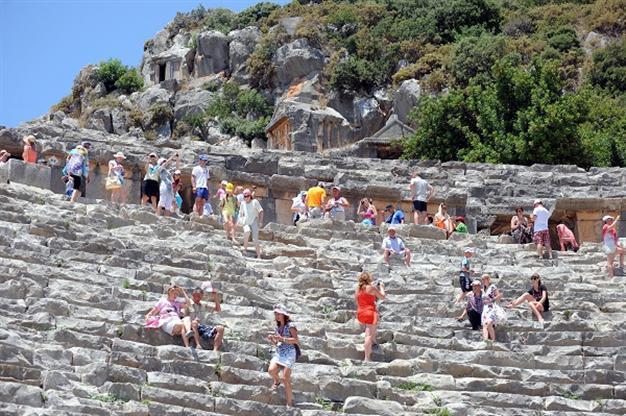Rock tombs focus of interest in Antalya
ANTALYA - Anadolu Agency

Myra served as the central city of the Lycian Union. Many structures were built and renovated in the city with the help of wealthy Lycians. AA photo
Rock tombs in the ancient city of Myra in the southern province of Antalya’s Demre district have drawn great interest from tourists throughout the year. The rock tombs date back to Lycians and are located in the upper part of a Roman theater in the ancient city, which is also famous for the Byzantine-era St. Nicholas Theater. The ancient city received over 130,000 visitors in the first five months of the year.The ancient city of Myra served as the central city of the Lycian Union. Many structures were built and renovated in the city with the help of wealthy Lycians. During the Byzantine era, it was one of the leading cities in terms of religion and administration. Because of earthquakes and floods, Myra began losing its importance in the 7th century and became a village in the 12th century.
The embossed and plain rock tombs are located on both sides of the Roman theater. Most of the tombs appear like large houses from a distance, while some are in the shape of a temple. The tombs show the Lycians’ use of wooden house architecture. Inside the tombs are human figures, depicting the deceased and their relatives.
Pamukkale University Arts and History Department member Murat Dağdelen said the rock tombs are suitable for carving and processing and each clan had its own burying traditions.
 “We can see the examples of every kind of tradition of burying the dead in Anatolia,” he said, adding that rock tombs had become common in 1000 A.D.
“We can see the examples of every kind of tradition of burying the dead in Anatolia,” he said, adding that rock tombs had become common in 1000 A.D. Dağdelen said the Urartians had become famous for processing tombs and made great contributions to give shape to rock tombs.
“Rock tombs exist in 47 different areas in Turkey. They were popularized by the Urartians and they now serve as sites for tourism. Particularly foreign tourists show great interest in rock tombs. They also contribute to the country’s economy,” he said.
Works for a giant museum
Other ancient Lycian works in Demre will be taken under protection in the Lycian Civilizations Museum, which is under construction in the Andriake port of Myria. Works for the museum will be finished soon.
Built with a cost of 8.355 million Turkish Liras, the museum has open and closed areas. The structures that have been unearthed during the five-year excavations will be included in the open section of the museum. The Roman-era granary, which was built in 129 A.D., has been restored for the closed section of the museum.
The 56-meter-long granary has seven rooms. The walls of the granary have been restored and its roof was covered with tiles. A 16-meter-long Roman-era boat was placed in front of the granary.
Also, an observation tower was built for visitors to observe birds living in the bird sanctuary next to the ancient city.
















